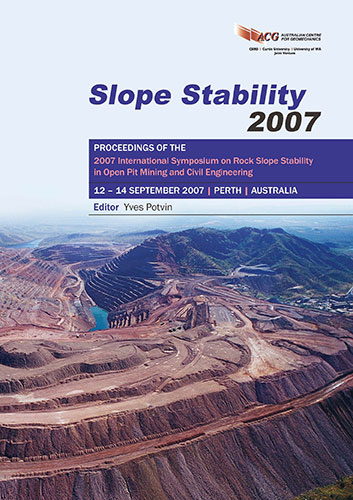Dealing with Uncertain Parameters in Rock Slope Stability Analysis

|
Authors: Pötsch, M; Pischinger, G; Schubert, W Paper is not available for download Contact Us |
DOI https://doi.org/10.36487/ACG_repo/708_7
Cite As:
Pötsch, M, Pischinger, G & Schubert, W 2007, 'Dealing with Uncertain Parameters in Rock Slope Stability Analysis', in Y Potvin (ed.), Slope Stability 2007: Proceedings of the 2007 International Symposium on Rock Slope Stability in Open Pit Mining and Civil Engineering, Australian Centre for Geomechanics, Perth, pp. 129-141, https://doi.org/10.36487/ACG_repo/708_7
Abstract:
The failure mechanisms of hard rock slopes are usually dominated by the joint and fault system of the rock mass, the properties of which show an inherent spread. The stability assessment according to block theory on the contrary follows a deterministic procedure. The determination of representative values for the analysis is therefore crucial. This paper addresses the steps for a slope stability assessment based on block theory. The focus is set on the kinematical analysis. The parameters involved in these analytical steps are discussed and their determination and statistical behaviour described. The kinematical analysis is illustrated using a simple polyhedral block. It is shown that non-daylighting joints may also increase the kinematical movability of a block. A case study outlines the determination of relevant rock mass parameters through field mapping and 3D imaging, the probabilistic data processing using simplified kinematical analyses, and the application in rock slope engineering. The result of the study is an optimised slope orientation easing further excavation without any need of additional measures.
References:
Barton, N. and Choubey, V. (1977) The shear strength of rock joints in theory and practice. Rock Mechanics 10(1-2)
pp. 1-54.
Beer, A.J., Stead, D. and Coggan, J.S. (2002) Estimation of the Joint Roughness Coefficient (JRC) by Visual
Comparison. Rock Mechanics and Rock Engineering 35(1), pp. 65-74.
Bingham, C. (1974) An antipodally symmetric distribution on the sphere. Ann. Stat. 2, pp. 1201-1225.
Brown, E.T. (ed.) (1981) Rock characterization, testing & monitoring. ISRM Suggested Methods. Pergamon Press,
211 pp.
Fisher, R. (1953) Dispersion on a sphere. Proceedings of the Royal Society of London, A217, pp. 295-305.
Gaich, A., Pötsch, M., Fasching, A. and Schubert, W. (2004) Measurement of rock mass parameters based on 3D
imaging. In Caratterizzazione degli ammassi rocciosi nella progettazione geotecnica. X Ciclo di Conferenze di
Meccanica e Ingegneria delle Rocce, Turin, 24 – 25 November 2004, Barla G. and Barla M. (eds.), Bologna,
Patron editore, pp. 21-45.
Gaich, A., Pötsch, M. and Schubert, W. (2006) Acquisition and assessment of geometric rock mass features by true 3D
images. In Proc. 41st U.S. Rock Mechanics Symposium – Golden Rocks 2006, Golden, 17 – 21 June 2006,
American Rock Mechanics Association, Paper No. 06-1051.
Goodman, R.E. and Shi, G.-H. (1985) Block Theory and Its Application to Rock Engineering. Prentice-Hall, New
Jersey.
ISRM – Commission of standardization of laboratory and field tests (1977) Suggested methods for the quantitative
description of discontinuities in rock masses. Int. J. Rock Mech. Min. Sci. & Geomech. Abstr. 15, pp. 319-368.
John, K.W. and Deutsch, R. (1974) Die Anwendung der Lagenkugel in der Geotechnik. In: Fecker, E., Gotz, H.-P.,
Sauer, G. and Spaun, G. (eds.) Festschrift Leopold Müller-Salzburg zum 65. Geburtstag. Privately published,
Karlsruhe, Federal Republic of Germany (DEU), Karlsruhe, pp. 137-159.
Liu, Q., Brosch, F.-J. and Riedmüller, G. (1998) Rock wedge failure potential assessment - Statistical aspects. In:
Moore, D. and Hungr, O. (eds.), Proc. 8th Int. IAEG Congress, 21-25 September 1998, Vancouver, Balkema,
pp. 1625-1632.
Markland, J.T. (1972) A useful technique for estimating the stability of rock slopes when the rigid wedge slide type of
failure is expected. Imperial College Rock Mechanics Research Report 19, 10 pp.
Mauldon, M. and Goodman, R.E. (1996) Vector Analysis of Keyblock Rotations. J. Geotechn. Eng. 122(12), pp. 976-
987.
Neubauer, F., Dallmeyer, R.D., Dunkl, I. and Schirnik, D. (1995) Late Cretaceous exhumation of the metamorphic
Gleinalm dome, Eastern Alps: kinematics, cooling history and sedimentary response in a sinistral wrench
corridor. Tectonophysics 242(1-2), pp. 79-98.
Ortner, H., Reiter, F. and Acs, P. (2002) Easy handling of tectonic data: the programs TectonicVB for Mac and
TectonicsFP for Windows(TM). Computers & Geosciences 28(10), pp. 1193-1200.
Priest, S.D. (1993) Discontinuity Analysis for Rock Engineering. Chapman & Hall, London.
Priest, S.D. (2004) Determination of discontinuity size distributions from scanline data. Rock Mech. Rock Engng.
37(5), pp. 347-368.
Pötsch, M., Schubert, W. and Gaich, A. (2004) Computer based stability analysis of rock slopes in a blocky rock mass.
In Proc. ISRM Regional Symposium Eurock 2004 & 53rd Geomechanics Colloquy, Salzburg, 7-9 October 2004,
Schubert (ed.), pp. 431-434.
Pötsch, M. and Schubert, W. (2006) Rotational kinematics of rock blocks with arbitrary geometries. Felsbau Rock and
Soil Engineering 24(3), pp. 30-36.
Reiter, F. and Acs, P. (2003) TectonicsFP - 32-bit Windows™-Software for Structural Geology, version 1.62.
Schieg, T. (2006) Investigations on the shear behaviour of artificial rock joints. Diploma Thesis, Institute for Rock
Mechanics and Tunnelling, Graz University of Technology, Austria.
Song, J.-J. (2006) Estimation of a joint diameter distribution by an implicit scheme and interpolation technique. Int. J.
Rock Mech. & Min. Sci. 43, pp. 512-519.
Tonon, F. (1998) Generalization of Mauldon’s and Goodman’s Vector Analysis of Keyblock Rotations. J. Geotech.
Geoenviron. Engineering 124(10), pp. 913-922.
Tonon, F. and Chen, S. (2005) Closed-form and numerical solutions for the probability distribution of discontinuity
diameters. In: Proc. 40th U.S. Rock Mechanics Symposium – Alaska Rocks 2005, Anchorage, 25-29 June 2005,
American Rock Mechanics Association, Paper No. 05-832.
Wallbrecher, E. (1986) Tektonische und gefügeanalytische Arbeitsweisen. Ferdinand Enke Verlag, Stuttgart, 244 pp.
Warburton, P.M. (1981) Vector Stability Analysis of an Arbitrary Polyhedral Rock Block with any Number of Free
Faces. Int. J. Rock Mech. Min. Sci. & Geomech. Abstr. 18, pp. 415-427.
Rock Slope Design
Slope Stability 2007, Perth, Australia 141
© Copyright 2025, Australian Centre for Geomechanics (ACG), The University of Western Australia. All rights reserved.
View copyright/legal information
Please direct any queries or error reports to repository-acg@uwa.edu.au
View copyright/legal information
Please direct any queries or error reports to repository-acg@uwa.edu.au